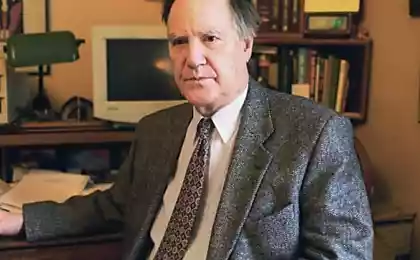622
The latest article by S. P. Kapitsa. The article is too good to forget it
After the collapse of science in our country, I was forced to spend a year abroad in Cambridge, where I was born. There I was attached to Darwin College; it is part of Trinity College, a member of which had once been my father. The College is engaged primarily overseas scientists. I was given a small scholarship that supported me, and we lived in the house that dad built. It was there, thanks to a completely inexplicable coincidence, I came across the problem of population growth.
I was previously involved in global issues of peace and balance that made us change point of view on the war with the advent of the ultimate weapon that can destroy all the problems, although not able to solve them. But all global problems in fact, the main is the number of people who live on the Earth. How many of them, where they were persecuted. This is the Central problem in relation to the rest, at the same time it was decided.
Twenty eight million nine hundred seventy seven thousand two hundred thirty one
Sergei Petrovich Kapitsa — Soviet and Russian physicist, TV presenter, editor in chief of the magazine "world of science", Vice-President of the Academy of natural Sciences. Since 1973, he led the popular science TV program "Obvious — improbable". The son of Nobel laureate Pyotr Leonidovich Kapitsa.
Not to say that before this nobody thought. People are always worried about how much they. Plato has calculated how much families should live in the ideal city, and he was good about five thousand. This was the visible world for Plato – the population policies of Ancient Greece in the tens of thousands of people. The rest of the world was empty – didn't exist as a real arena of action.
Such limited interests, oddly enough, there was even fifteen years ago, when I started to tackle the problem of population. To discuss problems of demography of all mankind was not accepted: in a decent society don't talk about sex, in a good scientific society were not supposed to talk about demographics.
It seemed to me that to begin with mankind in General, but such a thing was impossible even to discuss. Demography has evolved from smaller to larger: cities, countries to the world at large. Was the demographics of Moscow, the demographics of England demographics of China. How to deal with the world when scientists are barely able to cope with areas of one country? To get to the Central problem, had to overcome a lot of what the English call conventional wisdom, ie the generally accepted dogma.
But of course, I was in this area not the first. The great Leonhard Euler, who worked in various fields of physics and mathematics, in the XVIII century wrote the main equation of demography, which still use today. And among the General public the most know the name of the other founder of demography Thomas Malthus.
Malthus was a curious figure. He graduated from the theological faculty, but was very well prepared mathematically: he took ninth place at the Cambridge competition in mathematics. If the Soviet Marxists and modern social scientists know math at the level of the ninth grade of the University, I calmed down and believed that they are sufficiently mathematically equipped. I was in the office of Malthus in Cambridge and saw the book of Euler with his pencil marks – it is clear that he knew the mathematics of his time.
The Malthusian theory quite slender, but built on incorrect assumptions. He assumed that the number of people grows exponentially (that is, the growth rate is higher the more people already living on earth, giving birth to and raising children), but the growth is limited by resource availability, such as food. Exponential growth until complete exhaustion of resources is the dynamics, which we see in most living things. So even grow microbes in a nutrient broth. But the fact that we are not microbes.
Sixty two million three hundred seventy two thousand one hundred thirty two
People are not animals
Aristotle said that the main difference between man and animal that he wants to know. But to see how much we differ from animals, there is no need to get into our heads: just count how many we have. All creatures on Earth, from mice to elephants, obey the relationship: the more weight, the less individuals. Elephants little mice a lot. Weighs about a hundred pounds we should be on the order of hundreds of thousands. Now in Russia a hundred thousand wolves, a hundred thousand wild boars. These types exist in balance with nature. A man in a hundred thousand times more numerous! Despite the fact that biologically we are very similar to large monkeys, wolves or bears.
In the social Sciences, few exact figures. Perhaps the population of the country – the only thing that is unconditionally known. When I was a kid, I was taught in school that the Earth lives of two billion people. Now – seven billion. This growth we experienced during the lifetime of one generation.
We can roughly say how many people lived in the time of Christ's birth about one hundred million. Paleoanthropologists estimate the human population of the Paleolithic period about one hundred thousand – as much as we expected in accordance with body weight. But since then began to increase: first, barely noticeable, then faster, in our day a blast. Never before has humanity not grown so rapidly.
Before the war the Scottish demographer Paul Mckendrick proposed the formula of growth of mankind. And this growth was not exponential, but hyperbolic – very slow in the beginning and quickly accelerating in the end.
According to his formula, in 2030, the human population must tend to infinity, but this is clearly an absurdity: people are not biologically able to give birth in a finite time an infinite number of children. More importantly, this formula perfectly describes the growth of humanity in the past. This means that the growth rate was always proportional to the number living in the land of the people, and the square of that number.
Physicists and chemists know what this dependence: it is "the reaction of the second order", where the process rate does not depend on the number of participants and the number of interactions between them. When something is in proportion to the "n-square", is a collective phenomenon. Such, for example, a nuclear chain reaction in a nuclear bomb.
If every member of the community "Snob" write review to all the others, then the total number of comments will just be proportional to the square of the number of participants. The square of the number of people – number of links between them, a measure of the complexity of the system "mankind". The greater the difficulty, the faster the growth.
No man is an island: we live and die alone. We reproduce, eat, little differing in this from many animals, but the qualitative difference is that we exchange knowledge. We pass them by inheritance, we transmit them horizontally in universities and schools. Therefore, the dynamics of the other.
We don't just breed and multiply: we are making progress. This progress is quite difficult to measure numerically, but, for example, the production and consumption of energy can be a good criterion. And the data show that energy consumption is also proportional to the square of the number of people, that is the energy consumption of each person is higher the more the Earth's population (if every contemporary, from the Papuans to the Aleuts, to share with you the energy. –Primas'. ed.).
Our development is in the knowledge is the main resource of mankind. So, to say that our growth is limited by depletion of resources is a very rough formulation of the question. In the absence of disciplined thinking there is a lot of all kinds of horror stories.
For example, a couple of decades ago seriously talked about the depletion of stocks of silver, which is used for the manufacture of a film: that in India, in bollywood, removed many films that soon all the silver on earth will go into the emulsion of these films. Would, perhaps, have been, but then invented magnetic recording, which does not require silver. Such assessments – the fruit of speculation and sonorous phrases, which are designed to capture the imagination – are the only propagandistic and alarmist function.
The food in the world is enough for all – we had discussed this question in "the Roman club", comparing the food resources of India and Argentina. Argentina area less than one third of India, but in India forty times more of the population. On the other hand, Argentina produces so much food that can feed the whole world, not just India, if strained properly. It is not a lack of resources and their distribution.
Someone, it seems, joked that the socialism in the Sahara will be a shortage of sand; it is not a question of the amount of sand and its distribution. Inequality of individuals and peoples has always existed, but with the acceleration of the growth process inequality increases: balancing the processes just don't have time to work. This is a serious problem for the modern economy, but history teaches us that in the past humanity has solved such problems – uneven leveled so that the scale of humanity a General law of development remained unchanged.
The hyperbolic law of growth of mankind throughout history has shown a remarkable stability. In medieval Europe, plague was carried in some countries up to three quarters of the population. On the growth curve in these places there are really failures, but within a century the number of leaves on the same dynamics as if nothing had happened.
The biggest shock experienced by humanity – the First and the Second world war. If you compare the actual data of demography with the fact that the model predicts would appear that the total loss of humanity from the two wars be about two hundred and fifty million – three times more than any of the historians.
The population of the Earth has deviated from the equilibrium value at eight percent. But then the curve for several decades steadily goes on the same trajectory. "Global parent" has proved resilient, despite a terrible disaster, which has affected most countries of the world.
Fifty million three hundred nine thousand seven hundred eighty two
The times
In history classes, many students wonder: why periods become shorter and shorter? The upper Paleolithic lasted about a million years, and to the rest of human history there are only half a million. The middle ages – a thousand years is only five hundred. From the upper Paleolithic to the middle ages history, seems to have accelerated a thousand times.
This phenomenon is well known to historians and philosophers. The historical periods should not be the astronomical time, the current is uniformly and independently of human history, and its own system time. The time follows the same dependence as the energy consumption or population growth: the faster it flows, the higher the complexity of our system, that is, the more people live on Earth.
When I started this job, I did not expect that from my model logically follows the periodization of history from the Paleolithic to the present day. If we assume that history is not measured by the revolutions of the Earth around the Sun, and lived human lives, the shortening of the historical periods immediately receive an explanation.
The Paleolithic age lasted a million years, but the number of our ancestors was then only about a hundred thousand – it turns out that the total number who lived in the Paleolithic people is around ten billion. Exactly the same number of people passed through the earth for a thousand years of the middle ages (the human population – a few hundred million), and one hundred and twenty five years of recent history.
Thus, our demographic model divides the history of mankind on the same (not in duration, and content) pieces, for each of which there were about ten billion people. The amazing thing is that such periods existed in history and paleontology long before the advent of global demographic models. The Humanities, with all their problems with math, you can't deny intuition.
Now ten billion people are on the ground in just half a century. This means that the "historical era" has shrunk to a single generation. To ignore this is impossible. Today's teenagers don't understand what it was thirty years ago, Alla Pugacheva: "...and to wait can't you three people at the machine" – what machine? Why wait?
Stalin, Lenin, Napoleon, Nebuchadnezzar – for them it is what in grammar is called "pluperfect" is long past. It is now fashionable to blame the gap between generations, to dying traditions – but perhaps this is a natural consequence of the acceleration of history. If every generation lives in an era, the legacy of previous eras he may simply not be useful.
Fifty nine million two hundred sixty nine thousand six hundred forty
The beginning of a new
The compression of historical time has now reached its limit, it is limited to the effective generation length of about forty-five years. This means that you cannot continue the hyperbolic growth of the number of people – the fundamental law of growth is simply obliged to change. And he's already changing.
According to the formula, today we should be about ten billion. And we're just seven and three billion is a considerable difference that can be measured and interpreted. We are witnessing a demographic transition – a change from unrestrained population growth to some other method of progress.
For some reason, many like to see this as a sign of impending disaster. But the disaster here is more in people's minds than in reality. A physicist might call a phase transition happening: you put a pot of water on the fire, and for a long time nothing happens, only the rise of single bubbles. And then suddenly boils. And so mankind slowly there is an accumulation of internal energy, and then everything takes on a new look.
Good image – rafting on mountain rivers. Many rivers we have are shallow, so do so: build a small dam, accumulate a certain number of logs, and then suddenly open the floodgates. And the river runs wave, which carries the trunks – she runs faster than over the river. The worst place here is the junction where the smoke yoke, where the smooth flow of the top and bottom separated by a phase of chaotic motion. This is what is happening now.
Approximately in 1995, humanity has passed through the high-speed growth, when he was born eighty million people a year. Since then, the growth had significantly reduced. Demographic transition is a shift from growth mode to stabilize the population at no more than ten billion. Progress, of course, will continue, but will go at a different pace and on a different level.
I think that many of the troubles that we are experiencing a financial crisis and a moral crisis, and disorder of life is stressful, nonequilibrium state associated with the sudden onset of this transition period. In a sense, we are caught in the Inferno. We've learned that uncontrollable growth is our law of life. Our morality, public establishment, values were adapted to the mode of development, which has been unchanged throughout history and is changing now.
And changing very rapidly. And statistics, and the mathematical model indicate that the width of the transition is less than a hundred years. This despite the fact that it occurs simultaneously in different countries. When Oswald Spengler wrote about the "decline of Europe", he probably meant the first signs of the process: the concept of "demographic transition" was first formulated by the demographer Landry on the example of France.
But now the process has affected the less developed countries has almost stopped the growth of the population of Russia, stabiliziruemost the population of China. Perhaps the prototypes of the future world must be sought in the regions that first entered the transition area – for example, in Scandinavia.
Interestingly, in the course of the "demographic transition" Laggards are quickly catching up with those who have taken this path before. Pioneers – France and Sweden – the process of stabilization of the population took half a century and peaked at the turn of the XIX and XX centuries.
And for example, in Costa Rica or Sri Lanka that have passed the peak growth rate in the eighties, the whole transition takes several decades. The later a country enters into a phase of stabilization, the sharper it goes. Russia in this sense tends more to the countries of Europe – the peak velocity of growth we have left behind back in the thirties, and thus can count on a milder scenario of transition.
Of course, there is reason to fear this uneven process in different countries, which can lead to a sharp redistribution of wealth and influence. One of the most popular horror stories – "Islamization". But the Islamization comes and goes like no time in history has come and gone religious system. The law of population growth has not changed the Crusades or conquest of Alexander the great.
The same immutable laws will be valid in the period of demographic transition. I can't guarantee that everything will happen peacefully, but I don't think the process is really very dramatic. Maybe it's just my optimism vs pessimism of others. Pessimism has always been much more fashionable over, but I'm more of an optimist. My friend Zhores Alferov said that there were some optimists, because pessimists have left.
Five million seven hundred forty thousand eight hundred twenty four
I am often asked about the recipes – they used to ask, but I'm not ready to answer. I can't offer ready-made answers, to pose as a prophet. I am not a prophet, I'm just learning. History – like the weather. There is no bad weather. We live in such and such circumstances, and we must accept and understand these circumstances. I think that the step to understanding is reached.
They characterize a man of his word – parasites
N. In.Startseva: Obstetric aggression
I do not know how to develop these views from future generations; it's their problem. I did what you did: showed how we approached the transition point, and pointed out its trajectory. Can't promise you that the worst is behind us. But "terrible" is subjective.published
P. S. And remember, only by changing their consumption — together we change the world! ©
Source: www.aum.news/nauka/1206-poslednyaya-statya-s-p-kapitsy
I was previously involved in global issues of peace and balance that made us change point of view on the war with the advent of the ultimate weapon that can destroy all the problems, although not able to solve them. But all global problems in fact, the main is the number of people who live on the Earth. How many of them, where they were persecuted. This is the Central problem in relation to the rest, at the same time it was decided.
Twenty eight million nine hundred seventy seven thousand two hundred thirty one
Sergei Petrovich Kapitsa — Soviet and Russian physicist, TV presenter, editor in chief of the magazine "world of science", Vice-President of the Academy of natural Sciences. Since 1973, he led the popular science TV program "Obvious — improbable". The son of Nobel laureate Pyotr Leonidovich Kapitsa.
Not to say that before this nobody thought. People are always worried about how much they. Plato has calculated how much families should live in the ideal city, and he was good about five thousand. This was the visible world for Plato – the population policies of Ancient Greece in the tens of thousands of people. The rest of the world was empty – didn't exist as a real arena of action.
Such limited interests, oddly enough, there was even fifteen years ago, when I started to tackle the problem of population. To discuss problems of demography of all mankind was not accepted: in a decent society don't talk about sex, in a good scientific society were not supposed to talk about demographics.
It seemed to me that to begin with mankind in General, but such a thing was impossible even to discuss. Demography has evolved from smaller to larger: cities, countries to the world at large. Was the demographics of Moscow, the demographics of England demographics of China. How to deal with the world when scientists are barely able to cope with areas of one country? To get to the Central problem, had to overcome a lot of what the English call conventional wisdom, ie the generally accepted dogma.
But of course, I was in this area not the first. The great Leonhard Euler, who worked in various fields of physics and mathematics, in the XVIII century wrote the main equation of demography, which still use today. And among the General public the most know the name of the other founder of demography Thomas Malthus.
Malthus was a curious figure. He graduated from the theological faculty, but was very well prepared mathematically: he took ninth place at the Cambridge competition in mathematics. If the Soviet Marxists and modern social scientists know math at the level of the ninth grade of the University, I calmed down and believed that they are sufficiently mathematically equipped. I was in the office of Malthus in Cambridge and saw the book of Euler with his pencil marks – it is clear that he knew the mathematics of his time.
The Malthusian theory quite slender, but built on incorrect assumptions. He assumed that the number of people grows exponentially (that is, the growth rate is higher the more people already living on earth, giving birth to and raising children), but the growth is limited by resource availability, such as food. Exponential growth until complete exhaustion of resources is the dynamics, which we see in most living things. So even grow microbes in a nutrient broth. But the fact that we are not microbes.
Sixty two million three hundred seventy two thousand one hundred thirty two
People are not animals
Aristotle said that the main difference between man and animal that he wants to know. But to see how much we differ from animals, there is no need to get into our heads: just count how many we have. All creatures on Earth, from mice to elephants, obey the relationship: the more weight, the less individuals. Elephants little mice a lot. Weighs about a hundred pounds we should be on the order of hundreds of thousands. Now in Russia a hundred thousand wolves, a hundred thousand wild boars. These types exist in balance with nature. A man in a hundred thousand times more numerous! Despite the fact that biologically we are very similar to large monkeys, wolves or bears.
In the social Sciences, few exact figures. Perhaps the population of the country – the only thing that is unconditionally known. When I was a kid, I was taught in school that the Earth lives of two billion people. Now – seven billion. This growth we experienced during the lifetime of one generation.
We can roughly say how many people lived in the time of Christ's birth about one hundred million. Paleoanthropologists estimate the human population of the Paleolithic period about one hundred thousand – as much as we expected in accordance with body weight. But since then began to increase: first, barely noticeable, then faster, in our day a blast. Never before has humanity not grown so rapidly.
Before the war the Scottish demographer Paul Mckendrick proposed the formula of growth of mankind. And this growth was not exponential, but hyperbolic – very slow in the beginning and quickly accelerating in the end.
According to his formula, in 2030, the human population must tend to infinity, but this is clearly an absurdity: people are not biologically able to give birth in a finite time an infinite number of children. More importantly, this formula perfectly describes the growth of humanity in the past. This means that the growth rate was always proportional to the number living in the land of the people, and the square of that number.
Physicists and chemists know what this dependence: it is "the reaction of the second order", where the process rate does not depend on the number of participants and the number of interactions between them. When something is in proportion to the "n-square", is a collective phenomenon. Such, for example, a nuclear chain reaction in a nuclear bomb.
If every member of the community "Snob" write review to all the others, then the total number of comments will just be proportional to the square of the number of participants. The square of the number of people – number of links between them, a measure of the complexity of the system "mankind". The greater the difficulty, the faster the growth.
No man is an island: we live and die alone. We reproduce, eat, little differing in this from many animals, but the qualitative difference is that we exchange knowledge. We pass them by inheritance, we transmit them horizontally in universities and schools. Therefore, the dynamics of the other.
We don't just breed and multiply: we are making progress. This progress is quite difficult to measure numerically, but, for example, the production and consumption of energy can be a good criterion. And the data show that energy consumption is also proportional to the square of the number of people, that is the energy consumption of each person is higher the more the Earth's population (if every contemporary, from the Papuans to the Aleuts, to share with you the energy. –Primas'. ed.).
Our development is in the knowledge is the main resource of mankind. So, to say that our growth is limited by depletion of resources is a very rough formulation of the question. In the absence of disciplined thinking there is a lot of all kinds of horror stories.
For example, a couple of decades ago seriously talked about the depletion of stocks of silver, which is used for the manufacture of a film: that in India, in bollywood, removed many films that soon all the silver on earth will go into the emulsion of these films. Would, perhaps, have been, but then invented magnetic recording, which does not require silver. Such assessments – the fruit of speculation and sonorous phrases, which are designed to capture the imagination – are the only propagandistic and alarmist function.
The food in the world is enough for all – we had discussed this question in "the Roman club", comparing the food resources of India and Argentina. Argentina area less than one third of India, but in India forty times more of the population. On the other hand, Argentina produces so much food that can feed the whole world, not just India, if strained properly. It is not a lack of resources and their distribution.
Someone, it seems, joked that the socialism in the Sahara will be a shortage of sand; it is not a question of the amount of sand and its distribution. Inequality of individuals and peoples has always existed, but with the acceleration of the growth process inequality increases: balancing the processes just don't have time to work. This is a serious problem for the modern economy, but history teaches us that in the past humanity has solved such problems – uneven leveled so that the scale of humanity a General law of development remained unchanged.
The hyperbolic law of growth of mankind throughout history has shown a remarkable stability. In medieval Europe, plague was carried in some countries up to three quarters of the population. On the growth curve in these places there are really failures, but within a century the number of leaves on the same dynamics as if nothing had happened.
The biggest shock experienced by humanity – the First and the Second world war. If you compare the actual data of demography with the fact that the model predicts would appear that the total loss of humanity from the two wars be about two hundred and fifty million – three times more than any of the historians.
The population of the Earth has deviated from the equilibrium value at eight percent. But then the curve for several decades steadily goes on the same trajectory. "Global parent" has proved resilient, despite a terrible disaster, which has affected most countries of the world.
Fifty million three hundred nine thousand seven hundred eighty two
The times
In history classes, many students wonder: why periods become shorter and shorter? The upper Paleolithic lasted about a million years, and to the rest of human history there are only half a million. The middle ages – a thousand years is only five hundred. From the upper Paleolithic to the middle ages history, seems to have accelerated a thousand times.
This phenomenon is well known to historians and philosophers. The historical periods should not be the astronomical time, the current is uniformly and independently of human history, and its own system time. The time follows the same dependence as the energy consumption or population growth: the faster it flows, the higher the complexity of our system, that is, the more people live on Earth.
When I started this job, I did not expect that from my model logically follows the periodization of history from the Paleolithic to the present day. If we assume that history is not measured by the revolutions of the Earth around the Sun, and lived human lives, the shortening of the historical periods immediately receive an explanation.
The Paleolithic age lasted a million years, but the number of our ancestors was then only about a hundred thousand – it turns out that the total number who lived in the Paleolithic people is around ten billion. Exactly the same number of people passed through the earth for a thousand years of the middle ages (the human population – a few hundred million), and one hundred and twenty five years of recent history.
Thus, our demographic model divides the history of mankind on the same (not in duration, and content) pieces, for each of which there were about ten billion people. The amazing thing is that such periods existed in history and paleontology long before the advent of global demographic models. The Humanities, with all their problems with math, you can't deny intuition.
Now ten billion people are on the ground in just half a century. This means that the "historical era" has shrunk to a single generation. To ignore this is impossible. Today's teenagers don't understand what it was thirty years ago, Alla Pugacheva: "...and to wait can't you three people at the machine" – what machine? Why wait?
Stalin, Lenin, Napoleon, Nebuchadnezzar – for them it is what in grammar is called "pluperfect" is long past. It is now fashionable to blame the gap between generations, to dying traditions – but perhaps this is a natural consequence of the acceleration of history. If every generation lives in an era, the legacy of previous eras he may simply not be useful.
Fifty nine million two hundred sixty nine thousand six hundred forty
The beginning of a new
The compression of historical time has now reached its limit, it is limited to the effective generation length of about forty-five years. This means that you cannot continue the hyperbolic growth of the number of people – the fundamental law of growth is simply obliged to change. And he's already changing.
According to the formula, today we should be about ten billion. And we're just seven and three billion is a considerable difference that can be measured and interpreted. We are witnessing a demographic transition – a change from unrestrained population growth to some other method of progress.
For some reason, many like to see this as a sign of impending disaster. But the disaster here is more in people's minds than in reality. A physicist might call a phase transition happening: you put a pot of water on the fire, and for a long time nothing happens, only the rise of single bubbles. And then suddenly boils. And so mankind slowly there is an accumulation of internal energy, and then everything takes on a new look.
Good image – rafting on mountain rivers. Many rivers we have are shallow, so do so: build a small dam, accumulate a certain number of logs, and then suddenly open the floodgates. And the river runs wave, which carries the trunks – she runs faster than over the river. The worst place here is the junction where the smoke yoke, where the smooth flow of the top and bottom separated by a phase of chaotic motion. This is what is happening now.
Approximately in 1995, humanity has passed through the high-speed growth, when he was born eighty million people a year. Since then, the growth had significantly reduced. Demographic transition is a shift from growth mode to stabilize the population at no more than ten billion. Progress, of course, will continue, but will go at a different pace and on a different level.
I think that many of the troubles that we are experiencing a financial crisis and a moral crisis, and disorder of life is stressful, nonequilibrium state associated with the sudden onset of this transition period. In a sense, we are caught in the Inferno. We've learned that uncontrollable growth is our law of life. Our morality, public establishment, values were adapted to the mode of development, which has been unchanged throughout history and is changing now.
And changing very rapidly. And statistics, and the mathematical model indicate that the width of the transition is less than a hundred years. This despite the fact that it occurs simultaneously in different countries. When Oswald Spengler wrote about the "decline of Europe", he probably meant the first signs of the process: the concept of "demographic transition" was first formulated by the demographer Landry on the example of France.
But now the process has affected the less developed countries has almost stopped the growth of the population of Russia, stabiliziruemost the population of China. Perhaps the prototypes of the future world must be sought in the regions that first entered the transition area – for example, in Scandinavia.
Interestingly, in the course of the "demographic transition" Laggards are quickly catching up with those who have taken this path before. Pioneers – France and Sweden – the process of stabilization of the population took half a century and peaked at the turn of the XIX and XX centuries.
And for example, in Costa Rica or Sri Lanka that have passed the peak growth rate in the eighties, the whole transition takes several decades. The later a country enters into a phase of stabilization, the sharper it goes. Russia in this sense tends more to the countries of Europe – the peak velocity of growth we have left behind back in the thirties, and thus can count on a milder scenario of transition.
Of course, there is reason to fear this uneven process in different countries, which can lead to a sharp redistribution of wealth and influence. One of the most popular horror stories – "Islamization". But the Islamization comes and goes like no time in history has come and gone religious system. The law of population growth has not changed the Crusades or conquest of Alexander the great.
The same immutable laws will be valid in the period of demographic transition. I can't guarantee that everything will happen peacefully, but I don't think the process is really very dramatic. Maybe it's just my optimism vs pessimism of others. Pessimism has always been much more fashionable over, but I'm more of an optimist. My friend Zhores Alferov said that there were some optimists, because pessimists have left.
Five million seven hundred forty thousand eight hundred twenty four
I am often asked about the recipes – they used to ask, but I'm not ready to answer. I can't offer ready-made answers, to pose as a prophet. I am not a prophet, I'm just learning. History – like the weather. There is no bad weather. We live in such and such circumstances, and we must accept and understand these circumstances. I think that the step to understanding is reached.
They characterize a man of his word – parasites
N. In.Startseva: Obstetric aggression
I do not know how to develop these views from future generations; it's their problem. I did what you did: showed how we approached the transition point, and pointed out its trajectory. Can't promise you that the worst is behind us. But "terrible" is subjective.published
P. S. And remember, only by changing their consumption — together we change the world! ©
Source: www.aum.news/nauka/1206-poslednyaya-statya-s-p-kapitsy























